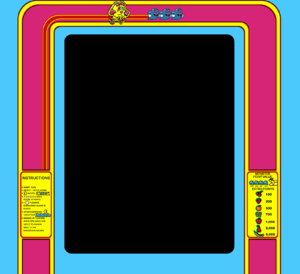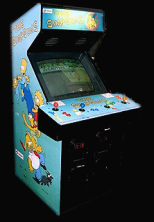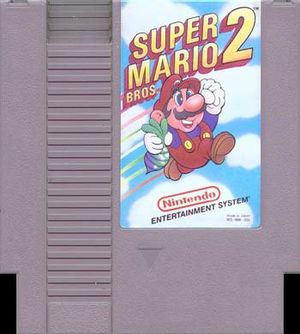Difference between revisions of "Screens, Titles & Extras"
Mortalpawn (talk | contribs) |
DeLuSioNal29 (talk | contribs) |
||
| (12 intermediate revisions by 3 users not shown) | |||
| Line 27: | Line 27: | ||
===Control Panels=== | ===Control Panels=== | ||
[[Image:controlpanel.png|right|thumb|Donkey Kong arcade control panel]]Control Panels (commonly referred to as cpanels) are pictures taken of control panels. Obviously, arcade cabinets will have control panels which can be a good item to display in front-end layouts to help remind the player what the controls looked like for the game-play. | [[Image:controlpanel.png|right|thumb|Donkey Kong arcade control panel]]Control Panels (commonly referred to as cpanels) are pictures taken of control panels. Obviously, arcade cabinets will have control panels which can be a good item to display in front-end layouts to help remind the player what the controls looked like for the game-play. | ||
| − | + | ||
<br style="clear:both;"/> | <br style="clear:both;"/> | ||
| Line 36: | Line 36: | ||
===History=== | ===History=== | ||
| − | History is a single element added to a front-end or emulator that shows historical information about each game. The most well | + | History is a single element added to a front-end or emulator that shows historical information about each game. The most well known version of this element is maintained for MAME. The History.dat can be downloaded an fused in with the pre-gameplay experience. These history files general show: |
*Description: A summary description of the game. | *Description: A summary description of the game. | ||
*Technical: All info about CPUs, Sound chips, etc. | *Technical: All info about CPUs, Sound chips, etc. | ||
| Line 51: | Line 51: | ||
===Icons=== | ===Icons=== | ||
| − | Icons are front-end specific. Not all front-ends use them, and not | + | Icons are front-end specific. Not all front-ends use them, and not every system has icons. MAME32 is the most common system to utilize icons. |
| − | Icons tend to be used for point and click GUI front-ends rather than ones with Windows hidden | + | Icons tend to be used for point and click GUI front-ends, rather than ones with Windows hidden or use arcade controls to select games. |
[http://mame32qa.classicgaming.gamespy.com/ Download Icons] | [http://mame32qa.classicgaming.gamespy.com/ Download Icons] | ||
| Line 70: | Line 70: | ||
A couple of BYOAC members have spent the time to create movies of gameplay and attract sequences for every (parent) game in mame. More info and links to obtain/share them in this [http://forum.arcadecontrols.com/index.php?topic=45467.0 thread.] | A couple of BYOAC members have spent the time to create movies of gameplay and attract sequences for every (parent) game in mame. More info and links to obtain/share them in this [http://forum.arcadecontrols.com/index.php?topic=45467.0 thread.] | ||
| + | |||
| + | ===Front End Start-up Movies=== | ||
| + | |||
| + | Front End Start-up Movies are user created movies that start up before the front end comes on. It give the arcade a custom look and feel. | ||
| + | |||
| + | [http://www.youtube.com/watch?v=B1hOz1CaZO0&feature=related See Video Example here] | ||
===Samples=== | ===Samples=== | ||
| Line 90: | Line 96: | ||
<br style="clear:both;"/> | <br style="clear:both;"/> | ||
==Element combinations== | ==Element combinations== | ||
| − | Below are common combinations for screens, titles and extras of different systems. Other elements such as icons, samples, and information | + | Below are common combinations for screens, titles and extras of different systems. Other elements such as icons, samples, and information files are also available, but tend to be front-end or emulator specific. |
{| align="center" valign="top" border="1" cellspacing="0" cellpadding="3" style="background:white; color:black; border:1px solid silver;" | {| align="center" valign="top" border="1" cellspacing="0" cellpadding="3" style="background:white; color:black; border:1px solid silver;" | ||
| Line 164: | Line 170: | ||
|} | |} | ||
| + | |||
| + | |||
| + | ===INI Files=== | ||
| + | 'INI' files are a group of files which categorize MAME games based on different factors. These are used by many front ends to help sort or filter the games. There have been a few formats through the year. | ||
| + | |||
| + | [http://www.mameworld.net/catlist/ catver.ini] - Genre type information on all games. LOTS of stuff here. Mame version added, Genre (fighters, maze etc), adult games, etc. | ||
| + | '''NOTE:''' The original site isn't being updated anymore. Here is a site with updated versions [http://www.progettoemma.net/?catlist catver.ini] | ||
| + | |||
| + | [http://fe.donkeyfly.com/controls/controls.php controls.ini] - The original controls for each game. Original description from photographs of the control panel. This isn't a complete list of all games, but a very accurate representation of those it does have. | ||
| + | |||
| + | [http://nplayers.arcadebelgium.be/ nplayers.ini] - Lets you know how many players the game supports and if it's simultaneous play or not. | ||
==See Also== | ==See Also== | ||
Latest revision as of 19:55, 17 May 2008
Many front-ends are able to display many different kinds of media elements for all the games from each system (arcade, consoles, handhelds, computers, etc). Generally, most systems will have the basic elements of screens and titles. Certain systems will have different elements that other systems don't have and vice versa. See also the MAME#Mame Support_Files page, some of those projects overlap.
Contents
Element examples
Artwork
Artwork is primarily used for arcade systems. Generally bezel overlays are the most common type of artwork, however some arcade games have artwork that is lit from behind that corresponds with game play (Gorf, Lunar Lander, etc).
Most of the time, a mask file will accompany the artwork. The mask is used by emulators to fuse the artwork in with the gameplay.
Front-ends generally don't use artwork, but some people like the option of showing this element. The mask file would most likely not be used in front-ends.
Boxes
Boxes are scans of game boxes from consoles, computers and handhelds. It can be another element added to the front-end layouts. It's rare to find used games that still come with the box. It's a rather unqiue element to add to front-end layouts as it can definately bring back forgotten nostalgic images from 'archive oblivion' that were simply thrown away after opening the game.
Cabinets
Cabinets are pictures taken of arcade cabinets. It's a very common element in front-ends due to the popular synergy of not only playing the game itself but also witnessing the nostalgic looks of the machine some people once stood in front of for endless hours inserting countless quarters into.
Cartridges
Cartridges are scans of the front of console game cartridges, SMC, HuCards, etc. Cartridge scans can come in two flavors - some people prefer to have just the scans of label cropped from the rest of the cartridge, but more common the entire cartridge is scanned. The latter takes a purist perspective because, for example, while most cartridges for the NES were grey, there was the occasional cart like Zelda which had a gold chrome finish.
Control Panels
Control Panels (commonly referred to as cpanels) are pictures taken of control panels. Obviously, arcade cabinets will have control panels which can be a good item to display in front-end layouts to help remind the player what the controls looked like for the game-play.
Flyers
Flyers are scans of flyers from the arcade indsutry for arcade games. Flyers were used as promotional items to increase the sales of games. They often show captured screenshots, pictures of the cabinet, descriptions of the game play, and concept art.
History
History is a single element added to a front-end or emulator that shows historical information about each game. The most well known version of this element is maintained for MAME. The History.dat can be downloaded an fused in with the pre-gameplay experience. These history files general show:
- Description: A summary description of the game.
- Technical: All info about CPUs, Sound chips, etc.
- Trivia: All interesting information about the game.
- Updates: All differences between different/alternate versions/revisions.
- Scoring: Scoring details.
- Tips and tricks: Various tipbits to assist gameplay.
- Series: All other games in a serie are listed here.
- Staff: Programmers, designers, composers, etc.
- Ports: All ported version are listed here.
- Sources: Information sources for the game.
An accurate History.dat for MAME maintained by Alexis Bousiges and contributors can be found at Arcade History.
Icons
Icons are front-end specific. Not all front-ends use them, and not every system has icons. MAME32 is the most common system to utilize icons.
Icons tend to be used for point and click GUI front-ends, rather than ones with Windows hidden or use arcade controls to select games.
Manuals
Manuals are scans of manuals that came with the game. Most of the time, each page is scanned and merged into one seemless document, usually Adbobe PDFs. Not all systems have manuals, but it can be a nice addition to display them with external applications so the player can easily refresh his/her memory of the game-play.
Marquees
Marquees are unique to arcade cabinets. When merged into layouts, it can be a very attractive combination of elements for bringing something special to game selection in the front-end.
Movies
Movies are brief movie captures of game play from systems. They are an excellent addition to front-ends as they add a dynamic element to the layouts.
A couple of BYOAC members have spent the time to create movies of gameplay and attract sequences for every (parent) game in mame. More info and links to obtain/share them in this thread.
Front End Start-up Movies
Front End Start-up Movies are user created movies that start up before the front end comes on. It give the arcade a custom look and feel.
Samples
Samples are sound files, mostly from arcade games, that could not be emulated or when emulated, from a purist perspective, did not sound like it used to in the "good-ol-days". Emulators are the primary users of the sample files. While this may seem out of place in the front-end catagory, the conveniant thing about the sample element is that it's easy to add these memorable sounds into the front-end experience.
Screens
Screens (also known as"snapshots" or "screenshots") are screen captures of the actual game in play. Where Titles tend to only have one posible screen capture, Screens can be captured at any moment of the game. Ideally, the Screen will be taken at an addtractive moment in the game-play.
Screens are the most common of front-end elements.
Download Console & Pinball Screenshots
Titles
Title screen captures are taken at the introduction screens of games. The Title generally shows the name of the game, some credits, "insert coin" or "select number of players" type of things. Almost every game has some sort of Title to capture. Some very early games did not have Titles and the game-play was all that was displayed.
Element combinations
Below are common combinations for screens, titles and extras of different systems. Other elements such as icons, samples, and information files are also available, but tend to be front-end or emulator specific.
| Artwork | Cabinets | Controlpanels | Flyers | Marquees | Movies | Screens | Titles | Boxes | Manuals | Cartriges | |
| Arcade | |||||||||||
| Consoles | |||||||||||
| Handhelds | |||||||||||
| Computers |
INI Files
'INI' files are a group of files which categorize MAME games based on different factors. These are used by many front ends to help sort or filter the games. There have been a few formats through the year.
catver.ini - Genre type information on all games. LOTS of stuff here. Mame version added, Genre (fighters, maze etc), adult games, etc.
NOTE: The original site isn't being updated anymore. Here is a site with updated versions catver.ini
controls.ini - The original controls for each game. Original description from photographs of the control panel. This isn't a complete list of all games, but a very accurate representation of those it does have.
nplayers.ini - Lets you know how many players the game supports and if it's simultaneous play or not.








